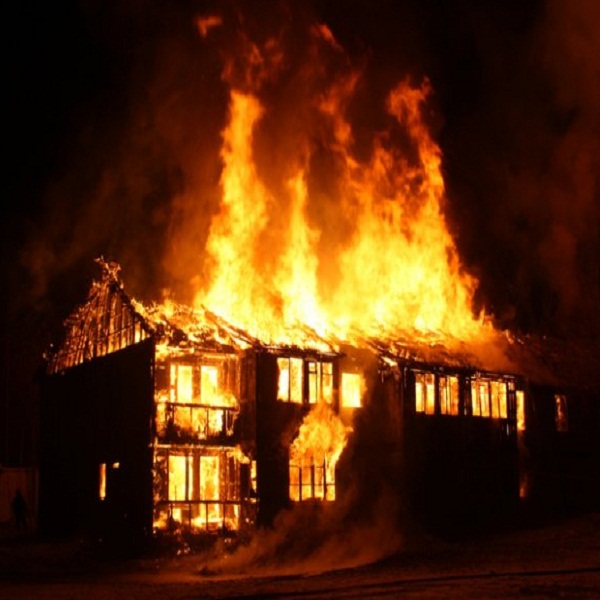Buildings need to be designed to offer an acceptable level of fire safety and minimise the risks from heat and smoke. The primary objective is to reduce to within acceptable limits the potential for death or injury to the occupants of a building and others who may become involved, such as the fire and rescue service. Also crucial are protecting contents and ensuring that as much as possible of a building can continue to function after a fire – and that it can be repaired. The risk to adjoining properties also needs to be considered, as well as possible environmental pollution.
There are two types of fuel that are under the influence of designers, the building fabric and its contents.
The fire safety of the fabric materials is often expressed in terms of its ignitability or combustibility, with particular regard to the structural elements which must remain in place for stability. The internal finishes may offer a fuel source and need to be carefully specified, while the materials of the building’s contents also provide varying fire risks, such as textiles, furniture and plastics.
Fire properties are also influenced by the materials behind the surface finish. This was the case in the fire at Kings Cross Station in 1987, with multiple coats of paint leading to the spread and severity of the fire.
Fire safety strategies
The main design options to ensure fire safety are:
Prevention: controlling ignition and fuel sources so that fires do not start.
Communications: if ignition occurs, ensuring occupants are informed and any active fire systems are triggered.
Escape: ensuring that occupants of buildings and surrounding areas are able to move to places of safety.
Containment: fire should be contained to the smallest possible area, limiting the threat to life safety and the extent of property likely to be damaged.
Extinguishment: ensuring that fire can be extinguished quickly and with minimal consequential damage.
The RIBA Plan of Work published by the RIBA in 2020 suggests that:
‘The Fire Safety Strategy forms an integral part of the design and must be integrated from the point at which a building project is identified and will continue though the ongoing Asset Management of the building, providing a golden thread of fire safety information. A high-level Site Appraisal to determine the fire safety suitability against the Client Requirements informs the viability of the project through Feasibility Studies. Layers of fire safety are integrated into the design as the project develops then constructed and managed in use in accordance with the Fire Safety Strategy and maintenance requirements.’
Prevention
The three components that are required for a fire to start are an ignition source, fuel and a supply of oxygen. Since it is difficult to exclude oxygen from a building, fire prevention tends to concentrate on the other two components.
Ignition prevention
To reduce the risk of ignition, designers can:
Design out ignition sources.
Enable buildings to be managed in such a way that the risk of ignition is eliminated.
There are a number of possible causes of ignition.
Natural phenomena
This includes earthquakes, forest fires, etc., but the risk most relevant to life in the UK is lightning.
Lightning damages buildings as an electrical current passes through building materials or along crevices between them, and energy is dissipated with heat reacting with the water content of building materials to produce very hot gases.
Buildings most at risk are those with tall towers and chimnies, as well as those at high altitudes, on hilltops or hillsides and genrally in isolated positions. Such structures should be provided with a lightning-conductor system to dissipate the electrical shock directly to the ground.
Human carelessness
Human carelessness is the most common cause of ignition and the most difficult to design against. Fires may be started by cigarettes, candles, matches, cooking and other appliances. Deliberate acts of arson are also very difficult to design out.
Technological failure
Building services in particular present a major ignition risk. Plant rooms, laboratories, boiler houses and large kitchens should be sited where their threat is minimised.
In the short term, services and installations should be correctly designed, specified, constructed, checked and commissioned. In the long term, checking and replacement cycles should be in place so that correct operation can be maintained.
Fuel limitation
Limiting the amount of fuel available will help to reduce risk in two ways:
Fire load: By controlling the amount of material which will burn and release heat to feed the growth of a fire.
Smoke load: It will also reduce the amount of smoke which can be produced.
Communication
Once a fire is detected (either by occupants or by automatic means), it is necessary to communicate the location of the fire to (other) occupants and to a control-and-response centre such as the fire and rescue service.
This will allow an assessment of the correct response to be undertaken, and if necessary, include alarms to be sounded, a controlled evacuation, triggering of smoke control systems or sprinklers.
Escape
Buildings must be designed so that occupants can escape safely if a fire breaks out. They must be able to reach a place of safety without being overcome by heat or smoke, and so the time taken to escape needs to be shorter than the likely time it will take for fire or smoke to spread.
This can be achieved by controlling fire spread and by ensuring that escape routes are easily accessible and neither too long nor too complex. People with mobility problems who may need assistance must also be considered.
Escape strategies might include:
Egress: simple direct escape from a building when an alarm is sounded.
Refuge: the use of the fire containment to provide a place of safety within a building.
Rescue: this is a last resort.
Containment
The ability of a building’s design to contain a fire once started is critical to the protection of the property, the lives of the occupants and also surrounding people and buildings. It is the ‘tactic’ most clearly covered by legislation and also one which insurance companies are most concerned with.
Containment should address both heat and smoke risks. It is possible to design passive and active fire containment measures.
Passive measures concern the nature of the building structure, subdivision and envelope. They are the properties of a building’s construction which serve to limit the spread of fire and smoke in case of a fire, such as a ‘half-hour’ fire door.
.Active measures are those which have to be activated either automatically or manually. This includes sprinklers, fire hydrants, extinguishers and smoke detectors. In the event of a fire, they will be activated by some agent or form of communication, informing people or equipment of the presence of fire and instructing them to take measures to contain its spread.
Passive fire resistance
The fire resistance of an element of construction is a measure of its ability to withstand the effects of fire in one or more ways, as follows:
Resistance to collapse, i.e. the ability to maintain loadbearing capacity (which applies to loadbearing elements only).
Resistance to fire penetration, i.e. an ability to maintain the integrity of the element.
Resistance to the transfer of excessive heat, i.e. an ability to provide insulation from high temperatures.
Some materials have inherent fire resistance, others need to have steps taken to improve this resistance.
There are three main methods of doing this:
Oversizing: deliberately increasing the size of an assembly so that part of it can be destroyed without affecting the structural performance of the rest.
Insulation: the provision of a layer of insulating materials around the assembly to protect it from the heat of a fire.
Dissipation: ensuring that heat applied to an assembly is rapidly dissipated to other materials or to the air, so that the temperature of the assembly is not raised to a critical level.
Passive structural protection
The level of fire protection appropriate to structural elements depends on:
The need for escape (to get occupants out).
Extinguishment (how long it will take to put out).
According to the Building Regulations Approved Document B, the structural elements which require fire protection are those which support a roof, but this does not normally include single-storey buildings. Exceptions to this are where an element of structure provides support or stability to elements, such as:
A separating wall.
A compartment wall.
An external wall which must retain stability to prevent fire spreading to adjacent buildings.
A support to a gallery or roof which also forms the function of a floor.
Most multi-storey, non-residential buildings are two, three and four storeys in height, and the majority are classed as offices, shops, commercial and assembly. This means that their dominant period of fire resistance is 60 minutes.
Once the length of time a structure must survive has been established, it is possible to design the structural elements to provide that degree of safety.
Passive compartmentation
The spread of fire can be restricted by sub-dividing buildings into a number of discrete compartments. These fire compartments are separated from one another by compartment walls and compartment floors made of a fire-resisting construction which hinders the spread of fire.
Fire compartmentation:
Prevents the rapid spread of fire which could trap the occupants of a building.
Reduces the chance of fires growing and minimises the danger to occupants, fire-and-rescue services, and people in the vicinity of the building.
Limits the damage caused to a building and its contents.
The degree of sub-division that should be provided by fire compartmentation will be dependent on:
The use of the building.
The fire load in the building.
The height of the building.
The availability of a sprinkler system.
Passive envelope protection
This aims to limit the threat posed by a fire to adjoining properties and people outside the building, as well as to limit the possibility of a fire starting as a result of a fire in an adjoining building.
Attention needs to be focused on the roof and external walls. Once alight, a roof can discharge flaming particles carried by convection currents, which pose a hazard if they land on other buildings. It is easier to design a roof that will resist penetration and fire spread than to ensure that a roof will not cause this problem.
External walls need careful consideration as heat radiated through them from a burning building might ignite adjoining buildings if they are too close. The danger of radiant heat can be reduced by restricting the number of openings in the external walls of a building if it is close to other buildings.
Active measures
These are measures that operate only in the event of a fire. They are mostly concerned with the particular problem of smoke control and the limitation of the spread of smoke throughout a building.
Active pressurisation
Even when well designed, it is inevitable that doors on escape routes will have to be opened and that smoke will therefore flow into the protected area. This danger can be reduced by using lobby access to staircases which provide a form of ‘airlock’ where only one door will be open at any time.
An alternative approach is to pressurise protected areas such as corridors and stairs. Fresh air is supplied to the area to be kept smoke-free and the air pressure is maintained above that of surrounding rooms. If a door into the pressurised area is opened, air will flow out rather than smoke flowing in.
Active venting
The simplest way of stopping smoke spreading within a building is to allow smoke to escape to the outside. This will not extinguish the fire but it will tend to contain smoke to its area of origin and gain time for people to escape and for measures to extinguish the fire to be taken.
In a single-storey building, this can be done through roof vents. In multi-storey buildings smoke ventilation systems using mechanical vent extraction can be used.
It may be possible to assume that initially smoke will exit directly through roof vents. But as the fire grows, a layer of smoke will build up beneath the ceiling or roof. This layer will get thicker as the fire grows and the smoke level will gradually descend.
Smoke venting systems must be designed to ensure that the smoke being added to the smoke layer is exactly balanced by that being expelled through the vents so that the depth of the smoke layer remains constant and does not descend to a level where it endangers the occupants (2.5m clear height).
Limiting the horizontal spread of smoke can be achieved by installing smoke curtains which are barriers that come down from the ceiling and create smoke reservoirs. Smoke curtains may be permanently in place or triggered to fall by fire.
Extinguishment
The most common extinguishing agents are:
Water
Foam
Carbon dioxide
Dry powder
Clean agents
Inert gases
These agents can be applied either by the occupants themselves, through auto-suppression systems, or by the fire and rescue service.
Source: designingbuildings










